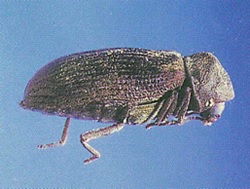Common furniture beetle
© Queensland Government
Native to Europe, common furniture beetles are an introduced pest of non-native pines and some hardwood timbers. They are found mainly in imported furniture and occasionally pine timber buildings in Queensland.
In Queensland, four species of anobiid beetles (Family: Anobiidae) may be found in or around buildings; Queensland pine beetles and common furniture beetles are economically significant, while pine bark anobiids and cigarette beetles are not very important.
Improved building practices for timber constructions have reduced the risk of attack and reports of damage.
Scientific name
Similar species
Description
- Adults:
- about 4mm long
- chocolate brown with reddish-brown legs
- head is concealed beneath the hooded (cowl-like) prothorax (first section)
- antennae end in a 3-segmented club
- covered with fine yellowish hairs with long rows of pits on the forewings
- compared to the Queensland pine beetle, they're larger, more rectangular and not shiny; microscopic examination is usually required to distinguish between the two species
- distinguish from powderpost beetles (Lyctus species) by the shape of the head and prothorax (first section).
- Eggs are ovoid and easily seen.
- Larvae:
- greyish white with a gold-brown head
- chestnut-brown mandibles (jaws)
- covered with fine hairs
- hook-shaped but curl into a tight ball when removed from their tunnel.
- See more images:
Distribution
- Established in southern states of Australia, as a pest of non-native pine timbers. It prefers cool, humid conditions.
- Occurs in cooler, upland areas in south-eastern Queensland (e.g. the Darling Downs).
- Not considered a pest in warmer regions.
Hosts
- A. punctatum is a pest of exotic pine timbers and some cabinet timbers.
- Commonly attacks European pine timbers, particularly timber in-service for more than 20 years.
- Found mostly in imported furniture and rarely in housing timbers.
- Susceptible species include:
- Baltic or Scots pine (Pinus sylvestris)
- hoop pine (Araucaria cunninghamii)
- kauri pines (Agathis spp.)
- some other pine woods.
- Hardwoods such as English oak (Quercus spp.) and spotted gum (Corymbia spp.) may also come under attack, although most Australian eucalypts appear to be resistant.
- Radiata Pine (Pinus radiata) in New Zealand is very susceptible, and treatment is mandatory when used for building construction or furniture. However, radiata pine in Australia has had few attacks despite widespread use — the reason for this anomaly is unclear.
Damage
- Larvae feed in timber for up to 5 years, creating tunnels and weakening the wood structure.
- Both the sapwood and heartwood of susceptible timbers are at risk.
- The tunnels run with and across the grain, giving the timber a honeycombed appearance. Frass may be seen packed loosely in the tunnels or protruding through holes.
- 1–2mm exit holes are left by the emergence of the adult beetles.
- Eggs are laid on the same wooden objects for several generations, decomposing up to a third of the original wood structure.
- Attacks on buildings are heaviest in damper areas including cellars, flooring, skirting boards and outbuildings. They are rare in roofing timbers due to higher temperatures, particularly under corrugated iron roofs.
Biology
- Females lay around 30 eggs in rough wood, cracks, the unprotected end grain of boards or old A. punctatum exit holes.
- Larvae feed in the wood for 2–5 years, then pupate.
- After hatching, adults gnaw through the wood, leaving a characteristic 1-2mm exit hole.
- Adults hatch from late spring to early autumn and live around 20–30 days.
- The females often lay their eggs onto the same wooden objects for several generations. The natural spread of infestation appears to be slow.
Control
- Natural predators of A. punctatum include beetles and wasps, however the development of a biocontrol program has had limited success.
- A. punctatum can be treated with thermal treatments, fumigation with inert gases (carbon dioxide or nitrogen), or application of chemical gases.
- Improved building practices for timber construction have reduced the risk of attack and reports of damage.
Resources and research
- Australian Pesticides and Veterinary Medicines Authority (APVMA)
- Auer, J, Opitz, C, Kassel, A. 2021, A new biological method to control Anobium punctatum, by using the parasitoid wasp Spathius exarator, L Journal of Applied Entomology. 145(1-2):73-81, viewed July 2023.
- Peters, BC, King, J, Wylie, FR. 1996, Pests of timber in Queensland. Queensland Forestry Research Institute, Brisbane.
- Last reviewed: 29 Sep 2023
- Last updated: 29 Sep 2023
